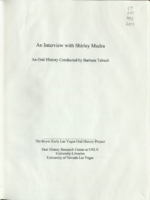Search the Special Collections and Archives Portal
Search Results
Boulder City, Nevada scaled down subdivision plat maps: includes Villa Del Prado, Lake Terrace, Eagle's Nest, Lakeview Sites, Lake Mead Villas, Lewis Homes, La Dolce Vita, Mountain Vista, Marina Highland Estates, Casa Boulder, la Mancha, Panda Homes, Lake Mountain Estates, and Laketree, 1967 to 1979
Level of Description
Archival Collection
Collection Name: UNLV University Libraries Collection of Boulder City, Hoover Dam, and Lake Mead National Recreation Area Maps and Brochures
Box/Folder: Flat File 01 (MISSING), Flat File 02 (MISSING)
Archival Component
Faye Rhea Porter oral history interview
Identifier
Abstract
Oral history interview with Faye Rhea Porter conducted by Barbara Tabach on June 13, 2012 for the Boyer Early Las Vegas Oral History Project. In this interview, Porter discusses her father's employment at the Nevada Test Site. Porter talks about her father being unable to describe the type of work he did with family or friends and tells anecdotes about the secrecy of the test site. She then recalls her sister and her employment at the Nevada Test Site until an accident on the way to the site resulted in her death.
Archival Collection
LULAC Council #11081 members and elected officials at the site of the future LULAC Multi-Purpose Bilingual Senior Center. Bob Agonia, Corrine Gutierrez, Tom Rodriguez, Manny Cortez, Thalia Dondero, Ron Lurie, Al Levy, Tom Moore, Pat Shalmy, John Lujan, Delia Martinez, and Ashley Hall (identified from left to right): photographic print, 1986 May 05
Level of Description
Archival Collection
Collection Name: Scott Henry Photographs of the Las Vegas, Nevada Latinx Community
Box/Folder: Box SH-052
Archival Component
#71390: Erica Marti, coordinator at UNLV for Workforce Development and Education initiatives associated with the NSF EPSCoR Solar Energy, Water Environment Nexus grant (bottom) assembles a portable solar energy classroom kit with UNLV students Francisco Chavarria (left,) Liz Heider and Amanda Vazquez at the Center for Energy Research Solar Site on the UNLV campus on February 17, 2017, 2017 February 17
Level of Description
Archival Collection
Collection Name: University of Nevada, Las Vegas Creative Services Records (2010s)
Box/Folder: Digital File 01
Archival Component
United States Department of the Interior Geological Survey, Federal Center, Denver, Colorado 80225, Wells and Springs in California and Nevada Within 100 Miles of the Point 37 degrees 15 minutes North, 116 degrees 25 minutes West, on the Nevada Test Site - Prepared Under Agreement No. AT(29-2)-474 for the Nevada Operations Office, U.S. Atomic Energy Commission, USGS-474-85, 1971
Level of Description
Archival Collection
Collection Name: Thomas P. O'Farrell Papers
Box/Folder: Box 13
Archival Component

Transcript of interview with Shirley Mudra by Barbara Tabach, November 30, 2011
Date
Archival Collection
Description
When Shirley Mudra arrived in Las Vegas in 1966, she came tearfully. But as the wife of a Nevada Test site manager and mother of three young children, she was accustomed to adapting. Indeed, she adapted and remains a Las Vegas resident. Shirley and her husband Paul (above photo) met while both were in the Air Force. She was the daughter of a Pittsburgh, Pennsylvania, homemaker and railroad worker and describes her upbringing. She also talks about her joy of enlistment in the Air Force and the transition to being a wife, mother and her employment at the Department of Energy. Shirley's narrative includes details of early Las Vegas life, raising children here and becoming part of the changing community through friendships.
Text
City of Las Vegas civil improvements, water lines, building additions and site ownership: contains architectural and civil drawings in Las Vegas, Nevada of the Union Plaza Hotel grounds, Helldorado grounds, and railroad underpass. Also includes maps of Clark Townsite additions, lease ownership along Main Street along Charleston Boulevard to Bonanaza Road, industrial stockyard ownership, and schedule of properties, 1906-1964 January 04
Level of Description
Archival Collection
Collection Name: Union Pacific Railroad Collection
Box/Folder: Flat File 157
Archival Component
Certificates recognizing work in the defense industry, newspaper clippings about the Nevada Test Site, correspondence, handbooks about nuclear safety, photographs, magazines including EG and G Inc. magazines the Sage and Desert Scope as well as Los Alamos Scientific Laboratory magazines LASL News and The Atom, 1942-1992
Level of Description
Archival Collection
Collection Name: Jack Livingston and Jacquelynn Smith Papers
Box/Folder: Box 01
Archival Component
Tancy and Richard Leonard oral history interview
Identifier
Abstract
Oral history interview with Tancy and Richard Leonard conducted by Barbara Tabach on September 18, 2012 for the Boyer Early Las Vegas Oral History Project. In this interview, the Leonards discuss their respective parents' employment at the Nevada Test Site. Frances’ father, John Elmgren, was the liaison between Reynolds Electric and the Atomic Energy Commission. Tancy describes the difficulties that came with having a parent working at the test site, the Huntridge Movie Theater, Vegas Village, and living in Las Vegas, Nevada in the 1950s and 1960s. Later in the interview, Richard discusses his father’s employment at the test site, observing the detonation of bombs, and the secrecy surrounding his father’s work. Lastly, the two describe the Westside and the historical significance of that area.
Archival Collection
Myers, W. A., 1997, "Environmental Impact Statement (EIS) for the F-22 Follow-on Operational Testing and Evaluation and Weapons School Beddown, Nellis AFB, Nevada." memorandum with attachment to W. Dixon (Yucca Mountain Site Characterization Office, U. S. Department of Energy), received April 1997, Chief, Environmental Planning Division. Environmental Conservation and Planning Directorate, U. S. Air Force, Headquarters, Air Force Center for Environmental Excellence. Brooks Air Force Base, Texas, 1997
Level of Description
Archival Collection
Collection Name: Environmental Radiation Protection Standards for Yucca Mountain, Nevada
Box/Folder: Box 24
Archival Component
